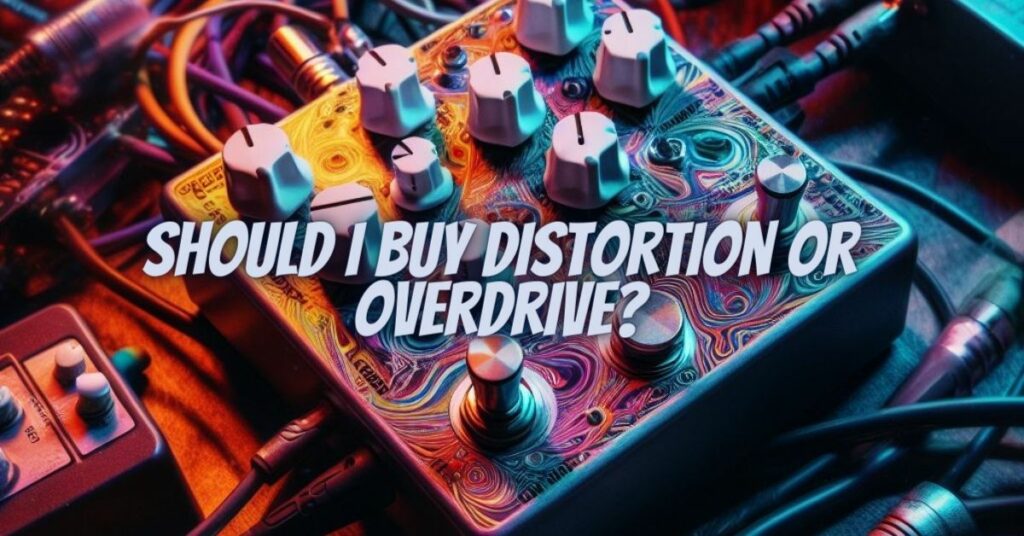One of the most fundamental choices guitarists face when shaping their tone is whether to use a distortion pedal or an overdrive pedal. Both effects are essential tools in a guitarist’s arsenal, offering distinct flavors of gain, and the decision between them can significantly impact your playing style and sound. This article will explore the differences between distortion and overdrive, helping you make an informed decision when considering which pedal to buy.
Distortion vs. Overdrive: What’s the Difference?
Before diving into the decision-making process, let’s clarify the fundamental differences between distortion and overdrive effects.
- Overdrive:
- Overdrive is often described as a “soft clipping” effect.
- It emulates the sound of a tube amplifier being pushed into natural breakup, creating warm, harmonically rich tones.
- Overdrive pedals are generally responsive to your playing dynamics and can produce a dynamic range of tones, from clean boost to mild saturation.
- Distortion:
- Distortion pedals provide a more aggressive and pronounced “hard clipping” effect.
- They introduce substantial gain and can transform a clean guitar signal into a heavily saturated, sometimes compressed, and sustain-rich tone.
- Distortion pedals often offer more pronounced sustain and compression compared to overdrive pedals.
Factors to Consider When Choosing Between Distortion and Overdrive
- Musical Style and Genre:
- Consider the music you play and the genre you want to excel in. Overdrive is often preferred in blues, classic rock, and jazz, whereas distortion is commonly used in heavier genres like hard rock and metal.
- Amp Type:
- Your choice may be influenced by the type of amplifier you have. Overdrive pedals tend to pair well with clean or lightly overdriven tube amps, while distortion pedals can add extra punch to an already overdriven amp.
- Gain Level:
- Determine the level of gain you need. Overdrive is suitable for adding grit and warmth to your sound without completely saturating it. Distortion, on the other hand, provides more intense, high-gain tones.
- Playing Dynamics:
- If you value expressive playing and dynamics, an overdrive pedal may be your choice, as it responds well to your picking intensity. Distortion, on the other hand, often compresses the dynamics for a more sustained and even tone.
- Pedal Versatility:
- Consider the flexibility of your pedal. Some distortion pedals offer a wide range of gain options, allowing you to dial in tones that resemble overdrive or push into high-gain territory.
- Tone Shaping:
- Overdrive pedals are generally known for their ability to enhance your guitar’s tone without significantly altering it. If you want to maintain the character of your guitar and amp, an overdrive may be preferable. Distortion pedals often offer more tone-shaping options, which can be great for achieving specific tonal objectives.
Examples of Popular Distortion and Overdrive Pedals
- Overdrive Pedals:
- Ibanez Tube Screamer: A classic overdrive pedal known for its smooth, mid-focused tone.
- Boss Blues Driver: A versatile overdrive pedal capable of producing warm, natural-sounding overdrive.
- Distortion Pedals:
- Pro Co Rat: A legendary distortion pedal renowned for its aggressive and gritty sound.
- Boss DS-1: A widely used distortion pedal known for its cutting, high-gain tones.
The decision between a distortion pedal and an overdrive pedal ultimately comes down to your playing style, musical genre, and tonal preferences. Both types of pedals are invaluable tools for guitarists, and many players find it useful to have both in their pedalboard for versatility.
Ultimately, the choice you make should be influenced by the sound you want to achieve and the equipment you’re working with. Experimentation is key in finding your unique tone, so don’t hesitate to try out different pedals to determine which one complements your playing style and musical goals.


